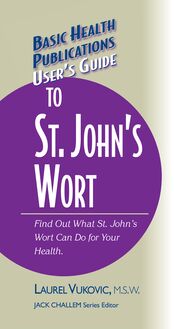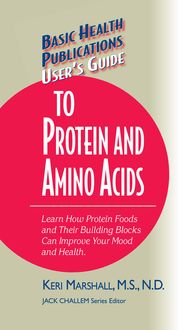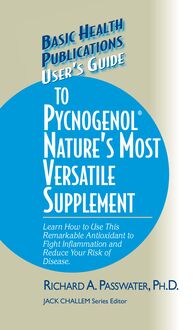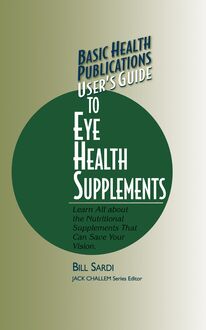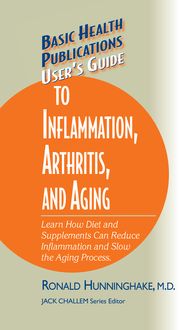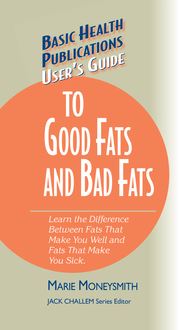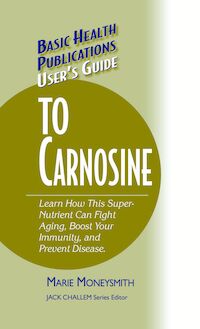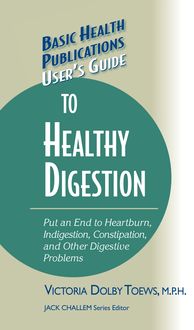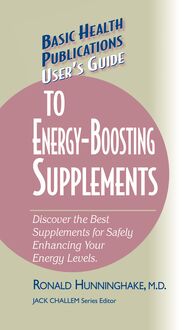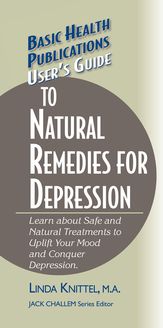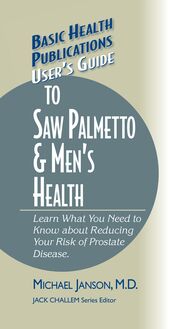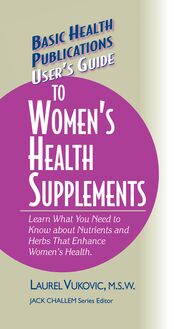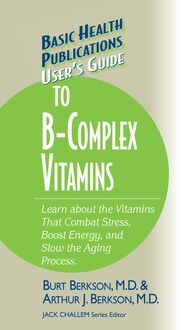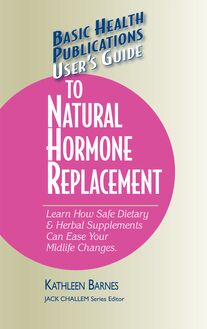User's Guide to Easing Menopause Symptoms Naturally , livre ebook
51
pages
English
Ebooks
2003
Vous pourrez modifier la taille du texte de cet ouvrage
Obtenez un accès à la bibliothèque pour le consulter en ligne En savoir plus
Découvre YouScribe en t'inscrivant gratuitement
Découvre YouScribe en t'inscrivant gratuitement
51
pages
English
Ebooks
2003
Vous pourrez modifier la taille du texte de cet ouvrage
Obtenez un accès à la bibliothèque pour le consulter en ligne En savoir plus
Publié par
Date de parution
01 janvier 2003
Nombre de lectures
0
EAN13
9781591206682
Langue
English
Publié par
Date de parution
01 janvier 2003
Nombre de lectures
0
EAN13
9781591206682
Langue
English
The information contained in this book is based upon the research and personal and professional experiences of the author. It is not intended as a substitute for consulting with your physician or other healthcare provider. Any attempt to diagnose and treat an illness should be done under the direction of a healthcare professional.
The publisher does not advocate the use of any particular healthcare protocol but believes the information in this book should be available to the public. The publisher and author are not responsible for any adverse effects or consequences resulting from the use of the suggestions, preparations, or procedures discussed in this book. Should the reader have any questions concerning the appropriateness of any procedures or preparations mentioned, the author and the publisher strongly suggest consulting a professional healthcare advisor.
Series Editor: Jack Challem
Editor: Laura Jorstad
Typesetter: Gary A. Rosenberg
Series Cover Designer: Mike Stromberg
Basic Health Publications User’s Guides are published by Basic Health Publications, Inc.
8200 Boulevard East
North Bergen, NJ 07047
1-800-575-8890
Copyright © 2003 by Cynthia M. Watson, M.D.
ISBN-13: 978-1-59120-668-2
ISBN-10: 1-59120-095-4
All rights reserved. No part of this publication may be reproduced, stored in a retrieval system, or transmitted, in any form or by any means, electronic, mechanical, photocopying, recording, or otherwise, without the prior written consent of the copyright owner.
Printed in the United States of America
10 9 8 7 6 5 4 3 2 1
C ONTENTS
Introduction
1. Premenopause and Menopause: Living in Transition
2. Hormone Replacement Therapy: Yes or No?
3. Herbal Alternatives
4. Is It Hot in Here or Is It Me? Controlling Hot Flashes
5. A Healthy Diet for Life
6. Healthy Breasts
7. Strong and Healthy Bones
8. A Healthy Heart
9. Cancer Prevention for a Lifetime
10. Sexual Vitality after Menopause
11. A Clear Mind, Emotions, and Thinking
Conclusion
References
Resources
I NTRODUCTION
I f you’ve picked up this book, you are probably already starting on the journey into menopause. Menopause is an inevitable event in every woman’s life. Some fear it; some welcome it. For some women, it is a relief; for others, the symptoms of menopause are life shattering. “The Change”—as it is so appropriately called—brings on a shift in many areas of a woman’s life. It isn’t just the end of the menses. It is a major transition into a new phase of life.
Our bodies are subject to rhythms and cycles. Once a woman starts menstruating in her teenage years, she can expect to experience a monthly cycle for somewhere between thirty-five and forty-five years. There can be pregnancies or changes that might cause the cycle to be irregular, but for most women, menses becomes a familiar friend. You set your calendar based on it. You know what to expect. You come to recognize the different signs as you shift from ovulation to menstrual flow.
Sometime between their late forties and mid-fifties, most women will start to notice changes in this cycle. By the time a woman reaches her midfifties, she will have entered into menopause. Some women have very few symptoms and hardy notice anything except that their cycle has stopped. Others have disabling symptoms and are in desperate need of help. Hot flashes, mood swings, sleep disturbances, changes in the vaginal tissues, loss of sexual desire, memory loss, weakening of bones: These symptoms can turn your life upside down.
The Conventional Approach
Conventional medicine has had one answer to help women during this time: hormone replacement therapy. It was estimated that in 1995, over 38 percent of postmenopausal women were using hormones to treat and prevent the symptoms of menopause. Some women have been taking hormones for more than twenty years on the recommendation of their physician.
In July 2002, the results of the Women’s Health Initiative were published in the Journal of the American Medical Association. It sent a shock wave into the medical community and put fear and concern into every woman taking hormones for menopausal symptoms. The study was discontinued early because of the increase in invasive breast cancer, strokes, and blood clots noted among the women taking the combination formula of Premarin and Provera.
As a result of the study, many women stopped taking their hormones and are looking for alternatives to help get through these changes more gracefully. Many others decided not to start taking hormones in the first place.
It Takes More than Hormones
It takes more than just popping a few pills to maintain health during this second half of life. The earlier you start treating yourself well, the better these years will be. The way you live your life when it comes to your diet, exercise, and supplements can make a great difference in your overall health and well-being. The science of longevity is evolving, and we know that prevention of disease is more important than treating a disease once it exists.
A woman’s life expectancy has radically increased over the last century. Now in the 21st century, a woman can expect to live a long, healthy life into her eighties, and maybe even nineties for our current generation. This means that many women will be living at least half or even more than half of their lives after menopause. Therefore, it is even more important for a woman to learn how to take care of herself. This book is a guide to help women navigate through the years of premenopause and menopause.You have the power to affect the way your body handles this change that is much more than taking a pill. What you eat, what supplements you take, and how you take care of yourself will all have a dramatic effect on your life. This book is a tool to guide you through this transition and into the second half of your life.
Many women in the early stages of premenopause and menopause are confused about what they can do to make the transition easier. The current conventional medical approach during these years is to use a low-dose birth control pill. For many women, this approach makes their symptoms worse, especially if they are the estrogen-dominant type. There are many other more natural alternatives to be found in the pages of this book.
Your unique medical history will shape your specific concerns. If many of your family members have had heart problems, then you will especially want to read the chapter on keeping your heart healthy. If you have had family members with Alzheimer’s disease, perhaps keeping your mind sharp will be important. You might also find that in some cases, the recommendations are very similar since we know that antioxidants are very important for protecting both the heart and the brain.
The first chapter will help you find ways to ease menopause’s early stages and even give you some suggestions to help you get the right tests done by your doctor. In the other chapters, you can read about specific symptoms and things that you can do to help keep your bones strong, protect your heart, or spice up your sex life.
Menopause is a time of great change in a woman’s life. That is why it is referred to as the “Change of Life.” Women do not only have physiological changes; powerful emotional and spiritual changes occur, as well, when a woman comes more into her strength and power.
As you pass through this amazing transition, learn how to turn it into a positive experience. We all want to live longer and healthier lives. This book is filled with tools to keep you healthy and vital. Menopause is an exciting and challenging time in a woman’s life. Let this book guide you through it.
CHAPTER 1
P REMENOPAUSE AND M ENOPAUSE: L IVING IN T RANSITION
L ast week a friend came to me looking tired and concerned. “I don’t know what’s happening to me,” she said. “I’m still having my period, but now I’m so hot, especially at night. I throw the covers off because I’m sweating, then I get freezing cold. I’m still having regular periods, though. Is this menopause? When does menopause start?”
For years before a woman goes into menopause, she may have problems as her hormones start to shift; this can be the beginning of menopause. We now use the term perimenopause for the changes in hormones that happen when a woman is still having periods.
The Cycle of Hormones
Luteal Phase
The second half of the menstrual cycle, from ovulation until the onset of the menstrual period.
The ovaries have a regular cycle as the hormones rise and fall. During the week of the menstrual cycle, hormone levels will be low. Then, at midcycle, sometime around day fourteen, estrogen will peak as an egg is released. This is called ovulation. During the second two weeks of the cycle, the ovary will produce estrogen and progesterone to prepare the uterus for the egg to implant. This time is called the luteal phase. In these approximately two weeks, the hormone levels will be at their highest. They will peak at between days twenty and twenty four, and then fall over the next few days. When hormone levels fall, the menstrual period begins.
Depending upon the overall health of the woman and her body’s ability to process these higher hormone levels, many fluctuations can occur. This is why so many women have different symptoms during this monthly ebb and flow. Hormones can have a dramatic effect on a woman’s feeling of well-being, her moods, and her emotions. These hormone changes, when out of balance, can wreak havoc in a woman’s life. She can feel totally out of control, wondering why she is doing things.
Because of the powerful effect that hormones have on our emotional life and stability, it is important for us to help educate each other and support each other as we move into this transition in life.
What Is Premenopause?
With menopause, a woman’s ovaries stop releasing regular eggs every month. Before the ovaries stop alto

